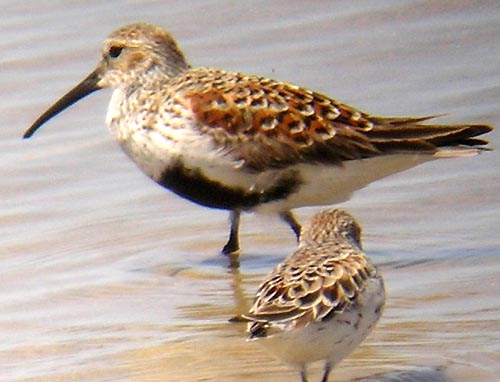Piper

Click here to see the pipers that wandered along the driveway by the creek and are taking a rest. They came one day and we had never seen them before. Then they went away and never have returned.

|
6 PIPERS.wmv Size : 4802.277 Kb Type : wmv |

“The Common Sandpipers were engaged in territorial fight. The individual that was doing the chasing pounced on its rival (above). The attacker had its wings fully out-stretched and tail fully fanned-out. Beautiful and intricate patterns, normally hidden, were exposed in a glorious display of its plumage. More ‘tail-fanning displays’ were later performed during subsequent interactions between the combative sandpipers. The fanning of tails were found to be in display by both the pursuer and the pursued during the pursuits (below). In addition, to appear intimidating, head would be stooped low and tail cocked or tilted towards its rival.
“A different display would be used when a sandpiper was defending its turf from an intruding bird. In the event of an intruding bird encroaching into its comfort zone, the ‘raised-wings display’ would be triggered. With wings fully out-stretched and raised vertically, the sandpiper would charge at the intruder. A sight to behold, the out-stretched wings would remain fully raised even as it raced towards the intruder (below). Both tail-fanning and raised-wing displays seemed to be expressed for intimidating rivals.
“When displays failed to intimidate, disputes escalated into fights. Only a few sparring sessions observed, but lots of chasing around with most avoiding fights by fleeing. Fights, when occurred, were fast and furious, on the ground or even in mid-air. Bills and feet were used as weapons. Physical contacts were definitely made but fortunately no casualties observed.
Raffles Museum of Biodiversity Research
THE SAND-PIPER.
HAVE you ever read about or seen a nice little bird called the sand-piper, or the summer snipe?
This bird does not make its home in the grove, or build its nest upon the branches of high trees. Near the shore of some lonely lake, upon the bank of some large river, or on the mud flats, marshes, or sandy beach of the ocean, the sand-piper may be seen thrusting its long bill into the mud or the sand in search of the
worms or insects upon which it feeds, or wading along the edge of the water after the insects there to be found.
Celia Thaxter has written a pretty little poem about this bird, and I will give you some of the
verses:—
"Across the narrow beach we flit,
One little sand-piper and I;
And fast I gather, bit by bit,
The scattered driftwood bleached and dry
The wild waves reach their hand for it,
The wild wind raves, the tide runs high,
As up and down the beach we flit,
One little sand-piper and I.
" I watch him as he skims along,
Uttering his sweet and mournful cry;
He starts not at my fitful song
Or flash of fluttering drapery.
He has no thought of any wrong,
He scans me with a fearless eye,
Staunch friends are we,
well-tried and strong,
The little sand-piper and I.
"Comrade, where wilt thou be to-night
When the loosed storm breaks furiously?
My driftwood fire will burn so bright,
To what warm shelter wilt thou fly?
I do not fear for thee, though wroth
The tempest rushes through the sky,
For are we not God's children both,
The little sand-piper and I?"
"Weet-weet"
is the "sweet, mournful cry," as the sand-piper rises from the level sand, in a rapid graceful flight; but near the shore the bird ever stays, for there is its food to be found; and near by is its little nest, by the side of some sheltering rock, or under the shade of some low shrub, or down among the coarse sea grasses,--a small round
hole lined with a bit of grass or heather, with four pretty eggs, the small ends turned toward the center, and so placed that if one is taken out, it can scarcely be fixed in the same position again.
The eggs are so nearly the color of the sand, and the little nest is so securely hidden, it would take a sharp-eyed boy or girl to find them. If the mother bird should see that her nest had been found, she would try by all the means in her power to turn the attention of the intruder upon herself, fluttering along the ground as if a wing were broken and she might become an easy prey, until far away from her precious treasures, then she would rise upon the wing and fly joyfully away.
When the young birds are hatched, like young chickens, they follow their mother here and there in search of food, down into the water, over the sands, across the marshes and the mud-flats, becoming every day larger and better able to fly, until, as the cold of autumn deepens, nature teaches them to fly away across the sea, down to the summer-land.
You will hear the bustle and the noise of their getting ready, but you will not see them go; for they fly away in the night. All along the old places where they used to flit you will miss them; no more "sweet, mournful cry," no more little foot-prints along the water side, until April shall come with her sunshine and her tears, and the cold winter is surely past.
Mrs. Mary Brainard.